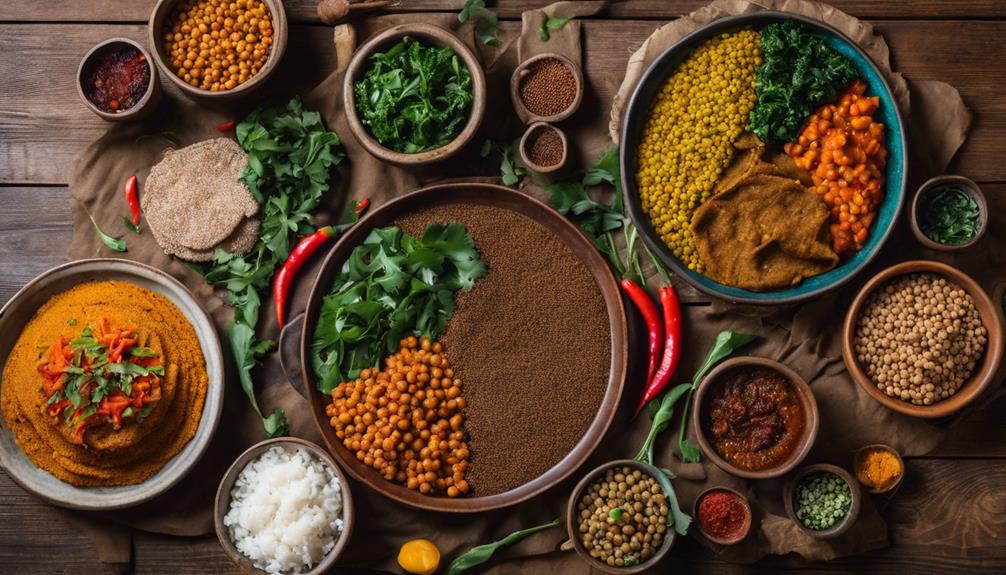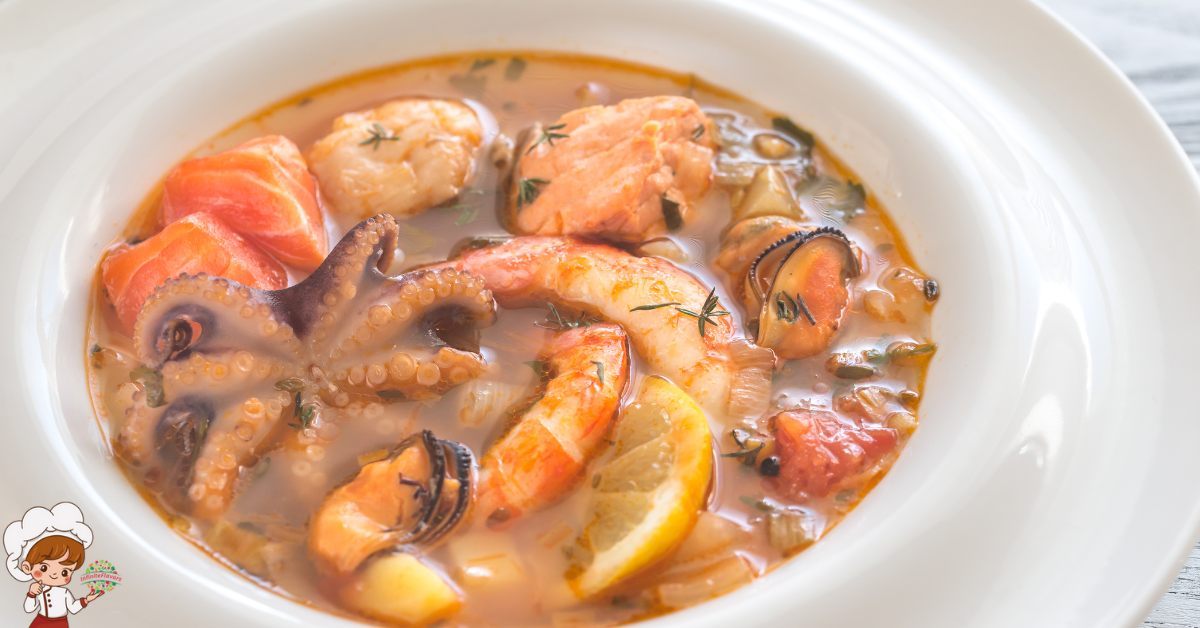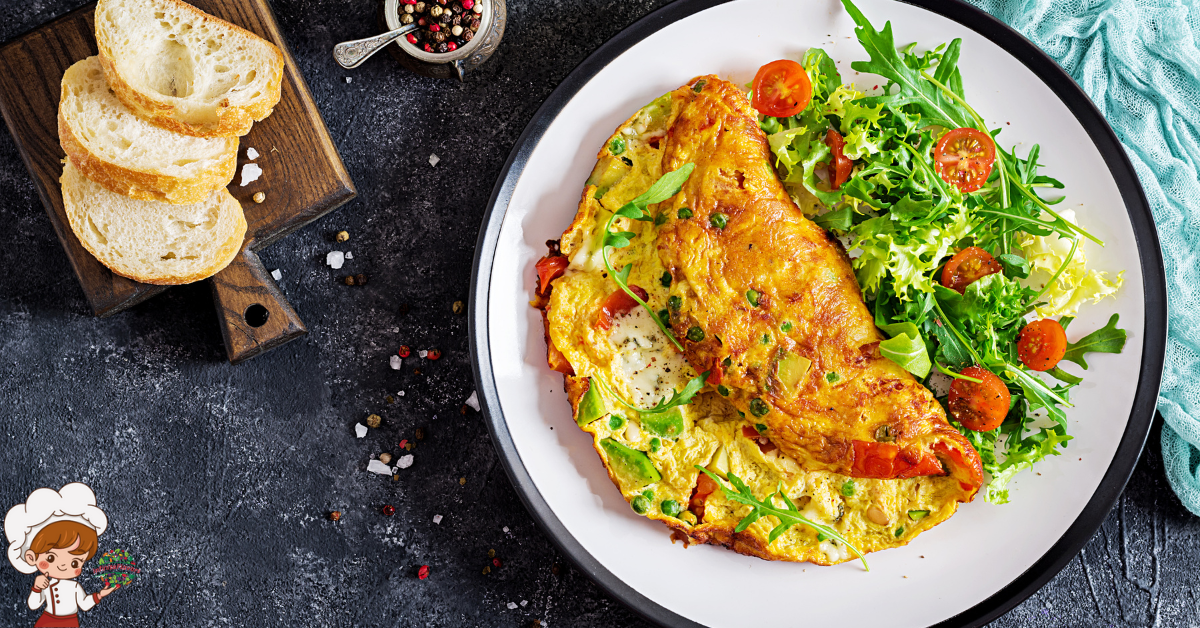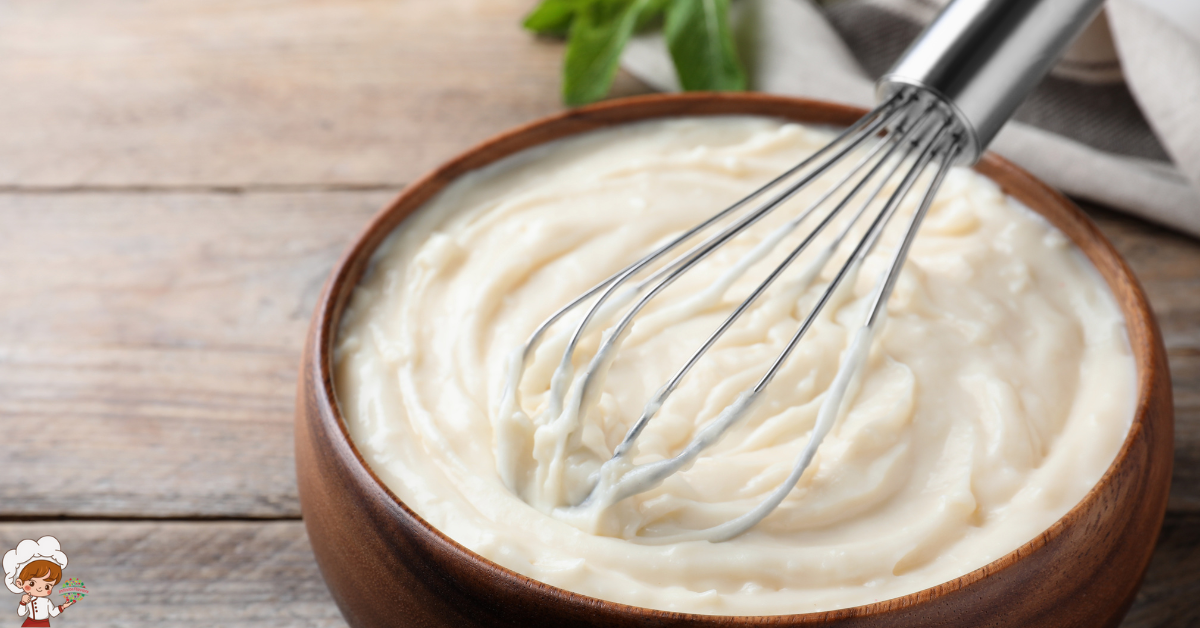14 Amazing Vegan-Friendly Ethiopian Dishes You Must Try

Vegan-Friendly Ethiopian Dishes You Must Try; If you’re enthusiastic to explore vegan-friendly Ethiopian cuisine, you must try dishes like Shiro and Misir Wot. Gomen offers a delicious way to enjoy collard greens, while Kik Alicha brings yellow split peas to life. Don’t miss the vibrant Beyaynetu platter, which showcases an array of stews served with injera, or the comforting Ful Medames made with fava beans. For a lighter option, Azifa is a revitalizing lentil salad. And if you have a sweet tooth, Atayef pancakes are a delightful treat. Stick around to discover even more tasty options and what makes them special!
Shiro
Shiro embodies the essence of Ethiopian comfort food with its rich, savory flavor profile. This delightful dish is primarily made from ground chickpeas or lentils, combined with a blend of spices that create a warm and inviting experience. You’ll find that shiro is versatile, offering several shiro variations to suit your taste. Some versions use spicy berbere, while others lean towards milder flavors with onions and garlic. You can customize your shiro with the addition of vegetables or even a dollop of spicy sauce on top.
The shiro history is as rich as its flavor. It dates back centuries and has roots in both traditional Ethiopian cooking and the culinary practices of various cultures in the Horn of Africa. Historically, shiro was a staple for many households, particularly during fasting periods when meat and dairy were avoided. Its nutritious ingredients guarantee that you get a satisfying meal without compromising on flavor.
When you sit down to enjoy shiro, you’re not just eating; you’re participating in a cultural experience that connects you to generations of Ethiopian heritage. Pair it with injera, the traditional Ethiopian flatbread, and you’ll have a meal that’s both hearty and fulfilling. Whether you’re a seasoned vegan or just looking to explore new cuisines, shiro should definitely be on your list of must-try dishes.
Misir Wot
Misir Wot is another staple in Ethiopian cuisine that’s sure to captivate your taste buds. This hearty dish features red lentils simmered to perfection, creating a rich and flavorful experience you won’t want to miss. When you take your first bite, the spicy flavor immediately grabs your attention, setting the stage for a delightful culinary journey.
The beauty of Misir Wot lies in its simplicity and depth of flavor. You’ll notice that it’s made with split red lentils, which cook down beautifully, resulting in a thick, stew-like consistency. The lentil preparation is key to achieving that perfect texture, ensuring each spoonful is satisfying and creamy.
In addition to the lentils, Misir Wot is infused with a blend of spices, including berbere, a traditional Ethiopian spice mix that combines chili peppers, garlic, ginger, and other aromatic spices. This mix adds that signature kick, giving the dish its distinctive spicy flavor. You might find yourself reaching for more, as the heat balances wonderfully with the earthy lentils.
Typically served with injera, a sourdough flatbread, Misir Wot is not just a meal; it’s an experience. You’ll enjoy tearing a piece of injera and scooping up the lentils, savoring the combination of textures and flavors. Whether you’re a seasoned vegan or just exploring Ethiopian cuisine, Misir Wot is a dish you need to try.
Gomen
Gomen is packed with nutritional benefits, making it a fantastic addition to your vegan meals. You’ll appreciate the traditional cooking techniques that bring out its rich flavors and textures. Let’s explore how this dish can enhance both your health and your dining experience.
Nutritional Benefits of Gomen
One of the standout ingredients in Ethiopian cuisine, Gomen, offers a wealth of nutritional benefits that make it a fantastic addition to any vegan diet. This dish, primarily made from collard greens, is packed with essential vitamins and minerals. Remarkably, Gomen is rich in vitamins A, C, and K, which support your immune system, bone health, and overall vitality.
When you incorporate Gomen into your meals, you’re also boosting your intake of dietary fiber. This helps promote healthy digestion and keeps you feeling full longer, making it a smart choice for anyone looking to manage their weight. Additionally, the antioxidants in Gomen contribute to overall gomen health, fighting oxidative stress and reducing inflammation in the body.
You can easily find numerous gomen recipes that highlight its versatility. Whether you enjoy it sautéed with spices or as part of a larger platter, it complements various dishes beautifully. By adding Gomen to your vegan meals, you’re not only savoring a delicious dish but also reaping numerous health benefits that support your well-being. So, why not explore the world of Gomen and discover how it can enhance your diet?
Traditional Cooking Techniques
When preparing Gomen, traditional cooking techniques play a significant role in achieving its authentic flavor and texture. You’ll want to start with fresh collard greens, often sautéed in a cooking vessel like a clay pot, which enhances the dish’s depth. Using traditional utensils, such as wooden spoons, allows you to stir gently, melding the greens with Ethiopian spices like cumin and coriander.
The process often involves slow cooking, which helps develop complex flavor profiles. You might even consider incorporating fermentation techniques, as some cooks allow the greens to marinate briefly, enhancing their taste. This method respects the heritage recipes passed down through generations, connecting you with the cultural significance of Ethiopian cuisine.
Gomen is typically enjoyed during communal dining, where sharing food brings people together. The dish’s vibrant colors and aromatic spices create an inviting atmosphere, encouraging everyone to partake. By embracing these traditional cooking techniques, you not only honor the original flavors of Gomen but also immerse yourself in the rich culinary heritage of Ethiopia. So gather your ingredients, and enjoy the experience of crafting this beloved vegan dish!
Kik Alicha
Kik Alicha is a delicious Ethiopian dish made primarily from split peas and seasoned with turmeric, giving it a vibrant color and unique flavor. You’ll find that its cooking method is simple yet effective, highlighting the natural ingredients. Let’s explore the key components and cooking techniques that make this dish a standout in vegan cuisine.
Key Ingredients Overview
A vibrant blend of spices and wholesome ingredients makes Kik Alicha a standout dish in Ethiopian cuisine. At the heart of this dish are lentil varieties, particularly yellow split peas, which provide a hearty texture and a rich source of plant-based proteins. These lentils absorb the flavors of the spices beautifully, creating a satisfying meal that’s both nutritious and delicious.
Ethiopian spices are essential to Kik Alicha’s unique taste. You’ll often find turmeric taking center stage, lending its vibrant color and warm flavor. Other spices like cumin and garlic enhance the dish, adding depth and complexity. The combination of these spices elevates the lentils, making each bite a delightful experience.
Traditional grains like injera serve as the perfect accompaniment, allowing you to scoop up the Kik Alicha while enjoying the tangy flavor of the fermented flatbread. Together, the lentils and spices create a symphony of tastes, showcasing the essence of Ethiopian cuisine. By incorporating these key ingredients, Kik Alicha not only celebrates plant-based eating but also brings a taste of Ethiopia right to your table.
Cooking Method Insights
Preparing Kik Alicha involves a straightforward yet rewarding cooking process that allows the flavors to meld beautifully. Start by sautéing sliced onions in a pot until they become translucent. You’ll want to use medium heat to avoid burning them. Once the onions are ready, it’s time for spice blending. Add turmeric and a pinch of salt to the mix, stirring them into the onions to release their aromas.
Next, incorporate your chopped garlic and ginger, letting them cook for a minute. This step enhances the dish’s depth. After that, toss in your yellow split peas, which should be rinsed beforehand. Add water or vegetable broth to cover the peas, and bring it to a gentle boil.
To guarantee even cooking, you can use steaming techniques by covering the pot. Reduce the heat and let it simmer for about 30 minutes, or until the peas are tender. Stir occasionally to prevent sticking. Once done, you can adjust seasoning and serve Kik Alicha warm with injera or rice. This dish’s comforting flavors will surely impress your taste buds!
Atayef
Although typically associated with Middle Eastern cuisine, Atayef can easily be adapted to fit vegan diets, making it a delightful treat for everyone. These stuffed pancakes are versatile and can be filled with a variety of vegan-friendly options. The traditional approach often includes nuts, sweetened coconut, or even fruit, but you can get creative with your atayef fillings. Imagine a mix of ground almonds, walnuts, and a drizzle of maple syrup for a sweet twist.
When it comes to atyaf variations, you’ll find that the pancakes can be either folded or rolled, depending on your preference. The batter is usually made from flour, water, and a bit of sugar, and you can modify it to guarantee it’s completely plant-based. To cook them, just pour a ladle of batter onto a hot skillet, let it bubble, and then fill it once it cools slightly.
For a unique touch, consider adding spices like cinnamon or cardamom to the batter, enhancing the overall flavor of your atayef. When serving, you can drizzle them with a vegan-friendly syrup or a sprinkle of powdered sugar for an extra touch of sweetness.
Whether you’re hosting a gathering or simply treating yourself, vegan atayef is sure to impress. It’s a wonderful way to enjoy a classic dish while staying true to your dietary choices. So, roll up your sleeves and start experimenting with these delightful pancakes!
Tibs Fitfit
Tibs Fitfit is a vibrant and satisfying dish that can easily be adapted to fit a vegan lifestyle. Traditionally, tibs fitfit combines sautéed meat with injera, but you can easily swap in vegetables or plant-based proteins to create a delicious vegan version. Start by using hearty ingredients like mushrooms, eggplant, or tempeh, seasoned with spices and sautéed to perfection.
The history of tibs fitfit traces back to Ethiopia’s rich culinary traditions, where food plays a significant role in social gatherings and family meals. You’ll find various tibs fitfit variations across the country, reflecting regional tastes and available ingredients. For instance, some might include a mix of lentils, tomatoes, and green peppers, while others may favor spices such as berbere or mitmita for an extra kick.
When making your vegan tibs fitfit, don’t hesitate to experiment with flavors. You can add a splash of lemon juice or a drizzle of tahini for creaminess. Pair your dish with injera, the spongy Ethiopian flatbread, which not only complements the flavors but also provides a fun way to enjoy your meal.
With its colorful presentation and comforting taste, tibs fitfit will surely impress both vegans and non-vegans alike. So, gather your ingredients and create your own unique tibs fitfit masterpiece that celebrates the essence of Ethiopian cuisine while adhering to your vegan lifestyle.
Salata
Salata embodies the freshness and vibrancy of Ethiopian cuisine, making it a perfect addition to any vegan meal. This invigorating salad typically combines chopped tomatoes, onions, and green peppers, creating a colorful and appetizing dish. You’ll appreciate how easy it is to prepare and customize to suit your taste.
One of the best things about salata is the variety of salata variations you can explore. You can choose to add ingredients like avocados, cucumbers, or even herbs like cilantro to enhance its flavor and nutrition. Each variation adds a unique twist, allowing you to create a salad that reflects your personal preferences.
When it comes to salata dressings, the classic choice is a simple mix of lemon juice, olive oil, salt, and pepper. This light dressing complements the fresh vegetables beautifully, elevating the dish without overpowering it. If you’re feeling adventurous, try adding a sprinkle of berbere spice for a kick or a dash of balsamic vinegar for added depth.
Salata is not just a side dish; it can stand on its own as a light lunch or a invigorating snack. You can enjoy it alongside other Ethiopian dishes or pair it with some crusty bread for a complete meal. So, the next time you’re looking for a quick, healthy, and flavorful option, remember that salata is a fantastic choice that celebrates the essence of Ethiopian cuisine.
Teff Injera
Teff injera is more than just a delicious Ethiopian staple; it’s packed with nutritional benefits that can enhance your vegan diet. If you’re curious about how to make authentic injera at home, you’ll find the process both rewarding and fun. Let’s explore the health perks of teff and the steps to create your own perfect injera.
Nutritional Benefits of Teff
One cup of teff contains a wealth of nutritional benefits that make it an excellent choice for anyone seeking a healthy diet. Originating from Ethiopia, teff is a tiny grain packed with protein, fiber, and essential nutrients. It’s gluten-free, making it perfect for those with gluten sensitivities, and its high fiber content promotes digestive health.
Teff is also rich in calcium, iron, and magnesium, which are crucial for maintaining strong bones and overall wellness. You’ll find that incorporating teff into your meals can help you meet your daily nutritional needs. Plus, it has a low glycemic index, making it a smart choice for managing blood sugar levels.
When exploring teff recipes, you’ll discover various ways to use this versatile grain. Whether you’re making traditional injera or adding it to salads and soups, teff enhances both flavor and nutritional value. By including teff in your diet, you not only enjoy its unique taste but also benefit from its impressive health properties. So, why not give it a try and experience the nutritional advantages of this ancient grain? You’ll be glad you did!
Making Authentic Injera At Home
Creating authentic injera at home can be a rewarding experience, allowing you to enjoy this staple of Ethiopian cuisine right from your kitchen. To start, you’ll need teff flour, water, and a bit of patience for the injera fermentation process. Mix one part teff flour with one part water in a bowl, covering it with a cloth. Let it sit at room temperature for 2-3 days, stirring occasionally. You’ll notice bubbles forming, indicating the fermentation is working its magic.
Once the mixture is bubbly and has a slightly sour aroma, it’s time to cook. Heat a non-stick skillet over medium heat and pour in a ladle of the batter, swirling it to cover the bottom. Cook until the surface is set and tiny holes form, which indicates the perfect injera texture. This should take about 2-3 minutes. Avoid flipping it; injera is traditionally cooked on one side only.
After it’s done, let it cool and serve it with your favorite vegan stews or vegetables. Enjoy the unique flavor and texture of your homemade injera, and appreciate the effort you put into creating this Ethiopian delight!
Azifa
Azifa is a rejuvenating Ethiopian dish that’s perfect for warm days or as a light appetizer. This invigorating lentil salad showcases the vibrant flavors of Ethiopian cuisine while being entirely plant-based. You’ll love its combination of textures and tastes, making it a delightful addition to any meal.
The main azifa ingredients include green lentils, which you’ll cook until tender, along with diced onions, tomatoes, and green peppers. For a zesty kick, you can add fresh herbs like parsley and a squeeze of lemon juice. Don’t forget the spices; a sprinkle of salt and a touch of pepper can elevate the flavor profile.
One of the best things about azifa is its versatility. You can experiment with azifa variations to suit your preferences. For instance, some people like to incorporate avocado or even roasted vegetables for a heartier dish. If you’re up for it, try adding a dash of berbere spice for an extra layer of warmth and complexity.
Azifa is not just easy to prepare; it’s also a feast for the eyes with its colorful presentation. Serve it chilled or at room temperature, and you’ll have a crowd-pleaser that everyone can enjoy. Whether you’re hosting a gathering or simply looking for a healthy snack, azifa is a fantastic choice that captures the essence of Ethiopian flavors. Give it a try and experience its unique charm for yourself!
Sambusa
Sambusa is a tasty pastry that can easily fit into your vegan diet. You’ll find a variety of fillings and spices, making it a versatile choice for any meal. Let’s explore the different ingredients and cooking methods that bring this delicious dish to life.
Ingredients and Variations
When it comes to Ethiopian cuisine, sambusa’s crispy, golden exterior holds a treasure trove of flavors inside. Traditionally filled with lentils, vegetables, and spices, you can easily customize these delightful pastries to suit your taste or pantry. For instance, while the classic sambusa often uses spiced lentils, you might opt for ingredients like chickpeas or even quinoa for a protein-packed variation.
Don’t hesitate to experiment with spice variations, either. If you love heat, try adding some minced jalapeños or a pinch of cayenne pepper to your filling. For a more aromatic profile, spices like cumin, coriander, or turmeric can elevate the taste profile of your sambusas.
If you’re looking for ingredient substitutions, consider using a vegan-friendly wrapper or even phyllo dough for a different texture. You might also swap out traditional onions for leeks or shallots, depending on what you have on hand. With these adjustments, you’ll create sambusas tailored to your preferences while still honoring the essence of Ethiopian cuisine. Immerse yourself in the world of sambusa possibilities and enjoy every bite!
Cooking Methods Explained
To bring your sambusas to life, the cooking method you choose can greatly impact their flavor and texture. You can opt for frying, baking, or even air frying, each offering distinct flavor profiles and textures. When frying, verify your oil is hot enough for a crispy exterior—typically around 350°F. If you prefer baking, brush the sambusas with a bit of oil for a golden finish.
For meal preparation, consider ingredient substitutions like using lentils or chickpeas instead of traditional fillings. Spice blends such as berbere can elevate your sambusas, giving them that authentic Ethiopian kick. Depending on regional variations, you might include different spices or fillings, so feel free to experiment.
As for kitchen tools, a good frying pan or baking sheet is essential. Cooking times vary: frying takes about 4-5 minutes per side, while baking might require 20-25 minutes at 400°F. When it comes to serving suggestions, pair your sambusas with a tangy dipping sauce and garnish them for an appealing presentation style. Enjoy the burst of flavors, and don’t hesitate to customize your sambusas to suit your taste!
Beyaynetu
Beyaynetu is a vibrant Ethiopian platter that showcases a delightful variety of vegan dishes, making it a perfect choice for plant-based eaters. This traditional dish has deep roots in Ethiopian culture, often served during communal meals and celebrations. The beyaynetu history reflects a rich culinary heritage, where families come together to share flavors and stories, emphasizing the importance of community and togetherness.
When you order beyaynetu, you’re greeted with a stunning presentation that’s as appealing to the eyes as it is to the palate. Typically served on a large, round platter, the centerpiece is injera, a soft, spongy flatbread made from teff flour. Surrounding the injera, you’ll find an array of colorful vegan stews and salads, each with its unique taste and texture. You might encounter spicy lentils, sautéed greens, and chickpeas, all beautifully arranged, inviting you to partake.
As you enjoy this dish, you won’t just savor the flavors; you’ll also experience the joy of sharing. Traditionally, Ethiopians eat beyaynetu with their hands, using pieces of injera to scoop up the various dishes. This interactive dining experience draws people closer together, enhancing the enjoyment of each bite. So, if you’re looking to explore Ethiopian cuisine, beyaynetu is an essential choice that promises a delicious adventure filled with history and vibrant flavors.
Doro Wat (Vegan Version)
One of the standout dishes in Ethiopian cuisine is Doro Wat, traditionally a spicy chicken stew, but its vegan version offers a delicious alternative that doesn’t compromise on flavor. This plant-based adaptation captures the essence of the original while using hearty ingredients like lentils or chickpeas to create a satisfying texture. The history of Doro Wat dates back centuries, often served during special occasions or religious holidays, and now you can enjoy it without any animal products.
In the vegan version, you’ll find a rich blend of spices, including berbere, which is essential for that authentic Ethiopian taste. The dish typically incorporates sautéed onions, garlic, and ginger, simmered with tomatoes and your choice of legumes. By embracing these doro wat variations, you can customize the stew to your preference—add more vegetables or adjust the spice level to suit your taste.
Serving your vegan Doro Wat with injera, the traditional Ethiopian flatbread, enhances the experience. The bread’s sour notes and soft texture complement the rich stew perfectly. It’s a beautiful way to share a meal with friends or family while introducing them to the vibrant flavors of Ethiopian cuisine. So, whether you’re a long-time fan of Doro Wat or trying it for the first time, this vegan version promises to delight your palate and honor the dish’s storied history.
Tikee Misir
Savoring Tikee Misir, a delightful lentil dish, is a must for anyone exploring vegan Ethiopian cuisine. This dish showcases the rich flavors of lentils, seasoned to perfection with spices like berbere and garlic. The tikee misir preparation is straightforward, making it an excellent choice for both novice and experienced cooks. You start by simmering red lentils until they’re tender, then sauté onions, garlic, and ginger in a bit of oil. Once the aromatics are fragrant, you stir in the berbere spice mix, adding a beautiful warmth to the dish. Finally, fold in the cooked lentils and let everything meld together for a few minutes.
What’s great about Tikee Misir is its versatility. You can find tikee misir variations that incorporate different vegetables or spices according to your taste. For instance, some people love adding tomatoes for a hint of sweetness, while others might toss in spinach or kale for extra nutrition. You can also adjust the spices—if you like it spicier, feel free to add more berbere or a sprinkle of chili flakes.
Serve Tikee Misir with injera, the traditional Ethiopian flatbread, to soak up the flavorful lentils, or pair it with rice for a hearty meal. No matter how you enjoy it, Tikee Misir is sure to leave your taste buds dancing and your heart happy. Don’t miss out on this essential part of Ethiopian vegan cuisine!
Ful Medames
Ful Medames embodies the essence of comfort food within vegan Ethiopian cuisine. This hearty dish, made primarily from fava beans, is not only delicious but also steeped in cultural significance. Often enjoyed for breakfast, Ful Medames is a staple that transcends mere sustenance; it represents community and togetherness.
When you sit down to enjoy Ful Medames, you’ll likely notice its serving traditions. It’s typically presented in a communal bowl, inviting everyone to share. You might find it topped with a drizzle of olive oil, chopped tomatoes, onions, and a sprinkle of fresh herbs, adding layers of flavor that enhance the natural earthiness of the beans. This simple yet satisfying combination makes every bite feel like a warm hug.
As you savor each mouthful, remember that Ful Medames isn’t just about the food; it’s about the experience. Families gather around the table, enjoying the dish while sharing stories and laughter. This communal aspect reinforces the importance of food in Ethiopian culture, where meals are often a focal point for connection.
You’ll also appreciate how versatile this dish can be. Whether you enjoy it with injera or bread, it’s a culinary canvas that allows for personal touches. In every bite of Ful Medames, you’re not just tasting fava beans; you’re partaking in a rich cultural heritage that emphasizes the joy of sharing and togetherness. So, next time you’re looking for a comforting vegan dish, Ful Medames is a must-try!
Frequently Asked Questions
Are Ethiopian Spices Vegan-Friendly?
Ethiopian spice blends, like berbere and mitmita, are typically vegan-friendly. You’ll love their rich flavors and health benefits, such as antioxidants and anti-inflammatory properties, making your meals both delicious and nutritious. Enjoy experimenting with them!
Where Can I Find Authentic Ethiopian Vegan Dishes?
You can find authentic Ethiopian vegan dishes at local Ethiopian restaurants and markets. Explore your area, ask for recommendations, and don’t hesitate to try new dishes. You’ll discover delicious flavors you won’t forget!
What Is the Best Way to Serve Injera?
To serve injera, lay it flat on a large platter, then add your favorite injera toppings like stews and salads. You can also roll it up for a fun, interactive serving style that enhances the experience.
Can I Make These Dishes Gluten-Free?
Yes, you can make these traditional dishes gluten-free! Use gluten-free alternatives like teff flour for injera. Experiment with other ingredients, ensuring they’re suitable, and enjoy delicious, gluten-free versions of your favorite dishes.
How Do I Store Leftovers of Ethiopian Dishes?
To store leftovers, place them in airtight containers and refrigerate. For reheating, use the microwave or stovetop, adding a splash of water to maintain moisture. Enjoy your delicious Ethiopian dishes all over again!
Conclusion
Now that you’ve discovered these 14 delicious vegan-friendly Ethiopian dishes, it’s time to get cooking! Each dish is packed with flavor and offers a unique taste of Ethiopian cuisine. Whether you’re enjoying a spicy Misir Wot or the comforting Gomen, there’s something for everyone. So gather your ingredients, invite some friends over, and plunge into the rich, vibrant world of Ethiopian flavors. You won’t regret it—your taste buds will thank you!








